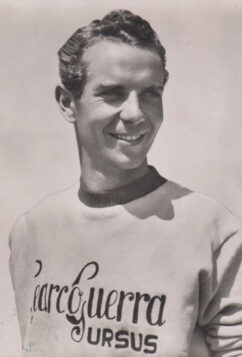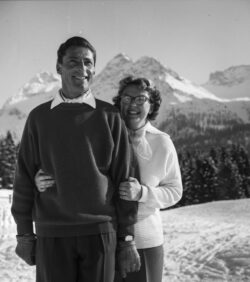Talent and
Tragedy


Every European country that embraces the cycling sport has its top stars. In Switzerland, the most famous racers just happened to be active during the 1950s, aka “The Golden Age of Swiss cycling.” We refer to none other than the “Two K’s”: Hugo Koblet and Ferdi Kübler. Today, let’s talk about the first of the two K’s, Hugo Koblet, the most legendary and tragic Swiss cyclist.
A delivery boy becomes a racer
Hugo Koblet was born in Zurich, Switzerland, on March 21, 1925. His parents ran a bakery in a workers’ neighborhood. At the age of nine, Hugo’s father died, and his mother and the kids had to run the bakery on their own. Hugo assisted the family business as a delivery boy. This might have helped plant the cycling seed in him who would later bloom into one of the best cyclists in Europe.
At age 17, Koblet got a job as a bicycle mechanic trainee at the famous Oerlikon Rennbahn. It was this job that exposed him to the great cyclists and team managers of the day. But this job related to cycling almost didn’t happen. Before getting the job at the Rennbahn, his mother had wanted him to be a silversmith and made him start an apprenticeship in that field. However, the harsh chemicals used in the metal industry caused him severe acne breakouts that forced him to give up his apprenticeship. One could say, thanks to his allergies, he got into cycling.
The first race he entered, he won, but he had not told his mother about it as she was against him cycling as a sport. It seems most parents back then didn’t’ see cycling as a viable profession, as the Swiss movie «Bäckerei Zürrer» of that time confirms. But the die was cast, and Hugo could only improve.
Koblet had a unique talent, and success came fast for him. He won the Swiss National track pursuit race in 1945 and turned pro in 1946. He was champion again of the Swiss track in 1947 and 1948. In 1948 Koblet went to the USA for the first time and won the Chicago six-day race and achieved 3rd place in the New York six-day track race. It was the trips to Chicago and New York that made him grow fond of the USA. He did a tour driving to Florida and California.

International success
In early 1950, his career got a big boost when fellow Swiss racer and friend Gottfried Weilenmann recommended him to Learco Guerra, a former Italian pro who turned into a bicycle industrialist. Guerra was putting together his first team for the 1950s Giro d’Italia. Hugo, unknown outside of Switzerland, got the job and catapulted to the top of the Giro classification and won! Koblet was the first Swiss and non-Italian to win the Giro d’Italia in 1950. The following year he won the 1951 Tour de France, one year after fellow Swiss racer Ferdi Kubler won it. He added these famous races to his many other Swiss championships and Tour de Suisse victories.
Hugo was nicknamed by French singer Jacques Trello the «Pedaleur de Charme» due to his smooth cycling motion on the bike but also his friendly charm with the fans throughout all social classes, competitors, and the ladies. In late 1951 Hugo went on a trip to Mexico to follow an amateur tour as a celebrity personality. Still, it’s said that something happened to him in Mexico that remained a mystery. Upon return, he never had the same cycling condition as before. Other sources identify an amphetamine treatment for an infection he suffered in June 1952 as the reason for his drop of power. Whatever was the cause, what was once easy to him became complicated. He visited specialists, but it was never found what was bothering him. He never won another international race again. He got second twice in the Giro d’Italia and won the Tour de Suisse, but never with the same ease.
No happy ending
Hugo was a bit too friendly, well mannered, and famous for not being able to say no. In an interview I had with Gottfried Weilenmann some time ago, he said they would agree on a time to meet for a training ride the following day. Upon arrival, Göpf, as everyone called Weilenmann, and fellow teammates would show up at Hugo’s house at 9 am only to find he was still asleep. Koblet would then apologize and say he would be right out, but oft times, Hugo would get distracted on the telephone, and before long, 45 minutes had gone by. Most times, some of the teammates would just leave and train without him. Gottfried said if Koblet had focused and trained seriously, he could have been better than Eddy Merckx. That’s a big claim, but he swore by it. Hugo couldn’t say no to people wanting favors, money, sponsorship engagements, and so on, and it started to take away from his performance.
In 1953 Koblet had married an up-and-coming model named Sonja Buehl. Hugo decided to retire in 1958, and they moved to Venezuela, that time a booming country. The plan was to work as a marketing representative for Agip Oil and the famous Italian brands Alfa Romeo, Fiat, and Pirelli. For many reasons, the time in the tropical paradise lasted for only two years. Koblet came back quietly to Zurich while his wife wanted to stay in Caracas. He lived alone in a studio apartment above a gas station he bought from Agip, directly next to Oerlikon Rennbahn. His life was never the same. Failed ventures and credits that were never paid back to him nagged on his peace of mind. Many said he was confused, depressed, and in debt. In November 1964, he crashed his Alfa Romeo into a tree on a country road outside Zurich. All indications point to suicide. A witness had seen him driving up and down the road several times before the crash – as if he was planning his dreadful ending.
Koblet never found the transition from celebrity cyclist to private citizen easy. With his death, Switzerland lost its most outstanding talent in cycling and a shining light. Perhaps the old saying, “the flame that burns twice as bright burns half as long,” is fitting for his life. His tragic life continues to fascinate until today. Several biographies have been written about Koblet, and a 2010 biopic brought the fascination of Hugo Koblet back to life.
In the life of the second K, Ferdi Kübler, there are many parallels to Hugo Koblet. But both his character and career were entirely different. More about «Ferdi National», as he was called, in our next brand story.
Alex


